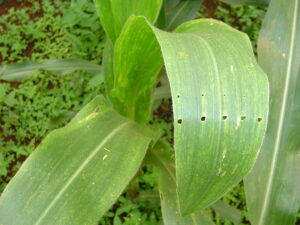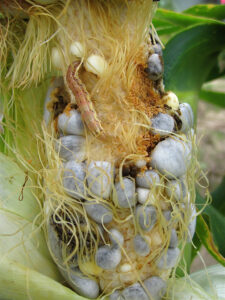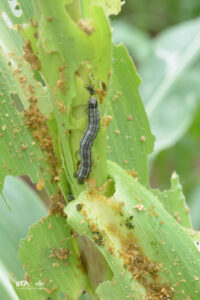Maize
Maize (Zea mays L.) is the world’s leading crop and is widely cultivated as cereal grain that was domesticated in Central America. maize is known as queen of cereals because of its highest genetic yield potential. Maize is the only food cereal crop that can be grown in diverse seasons, ecologies and uses. In India, maize is the third important food crop after rice and wheat.
Importance of crop-
- Maize is known as queen of cereals.
- Staple food for human being and quality feed for animal.
- One of the most versatile emerging crops having wider adaptability.
- Madhya Pradesh and Karnataka of the highest maize producer.
- It is cultivated on nearly 190 m ha in about 165 countries having wider diversity of soil, climate, biodiversity and management practices that contributes to 39 % of the global grain production.
- India contributes to 2% of the world’s total maize production.
- maize is rich in riboflavin, phosphorus, potash, iron, calcium, zinc, and vitamin B.
- Kharif (June – Nov)
- Rabi (Mid Nov – April)
- Spring (Jan – June)
Growing States-
Karnataka, Madhya Pradesh, Maharashtra, Bihar, Uttar Pradesh, Rajasthan, Madhya Pradesh, Himachal Pradesh, Punjab and J&K.
Smooth field for seed emergence and root growth. Deep tillage operation using mould board plough followed by two harrowing, zero -till conditions using happy seeder or zero till multi-crop planter.
- The optimum pH for corn is 5.8 to 6.8
- Farmer apply 1-3 soil tillage session.
- Loamy sand to clay loam soil used for maize production.
Sowing Method:
Maize is mainly sown directly through by using different method of tillage & establishment but during winters where fields are not remain vacant in time (till November), transplanting can be done successfully by raising the nursery.
Non Hybrid: About 8 kg of seed per acre should be used.
Hybrid: 7 kg of seed per acre should be used.
Seed Treatment-
- Bavistin + Captan in 1:1 2g/kg seed
- Captan 2.5g/kg seed
- Imidachlorpit 4g/kg or Fipronil 4ml/kg seed
The maize plant is a warm season crop. Germination and emergence are optimal when soils temperature are about 29⁰C TO 30⁰C.
Rainfall Maize can successfully grown in areas receiving an annual rainfall of 500 – 800mm which should be well distributed throughout its growing stage.
An irrigated crop in the dry season will require between 5 and 7 tonnes of water per hectare, while for the whole growing season, the total amount fluctuates between 6 to 9 tonnes of water per hectare.
| Stage | No. of Irrigation | Days after sowing |
| Heavy soil | ||
| Germination and Establishment | 3 | After sowing, life irrigation- 4th , 12th day |
| Vegetative | 2 | 25th, 30th day |
| Flowing | 2 | 48th,60th day |
| Maturity | 2 | 72nd ,85th day |
| Light soil | ||
| Germination and Establishment | 3 | After sowing, life irrigation- 4th , 12th day |
| Vegetative | 3 | 22nd ,32nd ,40th day |
| Flowing | 3 | 50th,60,72nd day |
| Maturity | 2 | 85th,95th day |
Potassium is the element which maize requires in good amount and it absorbs mostly in water stress conditions.
| Nutrient / Fertilizers | Dosage |
| Nitrogen | Around 28kg/ acre |
| Phosphorus | Around 5kg/ acre |
| Potassium | Around 19kg/ acre |
Dose of nitrogen:
- 80 kg/ha for rainfed kharif crop.
- 100-120 kg/ha for irrigated rabi crop.
Time of application:
- ½ of nitrogen at sowing
- ¼ of nitrogen at knee height stage (35 – 40 DAS)
- ¼ of nitrogen at tasseling stage
Dose of phosphorus:
- 40 kg/ha for rainfed crop
- 60 kg/ha for irrigated crop
Time of application:
Basal placement of phosphate in rows about 5-8 cm deep along seed rows in soil gives the best results.
Dose of Potassium:
Crop may be fertilized with 40 – 60 kg/ha K2O for a remunerative return.
Time of application:
Potassium is to be applied as basal dose along with phosphorus at the time of sowing
- weed completion is 15 – 45 days after sowing
- Recommended dose of Atrazine at pre – emergence 25 kg/ha.
- Apply herbicide when there is sufficient moisture in the soil.
- Do not disturb the soil after herbicide application.
1. Downy Mildew-
Causal Organism – Peranosclerospora sorghi
Symptoms:
- Systemic infection as chlorosis which appears 10-14 days.
- Leaves tend to be narrower and more erect.
- Plants infected early usually die at four weeks after infection.
- Chlorosis is noticeable on the lower half of the leaf: Half-leaf symptom
- Chlorosis gradually covers the entire leaf surface at later stage
- A white downy growth is seen on the lower leaf surface under humid warm conditions
- Systemically infected plants do not form cob and if it forms they are small and poorly filled
Favourable Conditions:
- Temperature ranging from 24-26o C.
- Continuous drizzling / rainfall.
- Relative humidity more than 80 %
Management:
- Use disease free healthy seeds.
- Drying seed to less than 14% moisture.
- Deep tillage and crop rotations for more than three years
- Roguing of diseased plants and alternate grass hosts
- Use disease resistance hybrids
- Seed treatment with metalaxyl @ 6g/kg of seeds
- Foliar spray with metalaxyl + mancozeb @ 1000 g or mancozeb 1000 g/ha after initial symptom / 20 DAP and 40 DAP
2. Turcicum leaf blight:
Causal Organism – Exserohilum turcicum &Helminthosporium maydis
Symptoms:
- Long cigar-shape grey-green to tan-coloured lesions on lower leaves.
- Tan lesions are slender and oblong tapering at the ends ranging in size 1 to 6 inches.
- Lesions run parallel to leaf margins and they coalesce and cover enter leaf.
- Spores are produced on the underside of leaf.
- Below the lesions, fungus giving the dusty black/green fuzz appearance
- Leaves become greyish-green and brittle, resembling leaves killed by frost.
Favourable Conditions:
- Wet humid cool weather typically found later in the growing season.
Management
- Burn or bury the Infected maize stubbles.
- Spray mancozeb or zineb @ 2-4 g/l or propiconazole 25% EC @ 1ml/l on 35 and 50 DAS
3. Charcoal Rot-
Causal Organism- Macrophomina phaseolina
Symptoms:
- Plants exhibit wilting symptoms
- Plants mature, the fungus spreads into the lower internodes of the stalk
- Causing premature ripening, shredding and breaking at the crown region
- Stalk of infected plants are with greyish streak
- The pith becomes shredded and greyish black minute sclerotia develop on the vascular bundles
- Shredding of the interior of the stalk often causes stalks to break at crown
Favourable Conditions
- Dry and hot weather during and after flowering favours the disease.
- Soil temperature 30 – 42°C, low soil moisture and low soil pH (5.4 – 6.0) .
Management
- Follow crop rotation
- Avoidance of water stress at flowering time reduced disease incidence
- Avoid nutrient stress.
- Apply potash @ 80 kg/ha in endemic areas
- Soil application of P. fluorescens (or) T. viride @ 2.5 kg / ha + 50 kg of well decomposed FYM (mix 10 days before application) or sand at 30 days after sowing.
4. Common Rust-
Causal Organism- Puccinia sorghi
Symptoms:
- Minute flecks are appeared on both sides of leaves.
- Circular to elongate cinnamon brown, powdery, erumpent pustules on both leaf surfaces
- As the crop matures brownish black pustules develop
- In severe cases infection spreads to sheath and other parts
Favourable condition:
- Cool, warm and moist weather (15 – 25o C)
Management:
- Remove the alternate hosts.
- Collect the remains of the crop and destroy by burning or burying
- Foliar spray of kresoxim-methyl 44.3% SC @ 1 ml/l or tebuconazole @ 1ml/l orchlorothalonil or mancozeb 2 ml/l at 35 and 50 DAS
5. Aspergillus Rot-
Causal Organism- Aspergillus flavus and A. parasiticus
Symptoms:
- Appears as an olive-green mould on the kernels from the tip of the ear
- Fungal spores appear as powdery and may disperse like dust when you pull back the husk
- Fungus produces a mycotoxin known as aflatoxin (B1, B2, G1 and G2)
- Aflatoxin affects grain quality and marketability, as well as livestock health if the grain is consumed
- Aflatoxin is extremely carcinogenic and most countries have regulations (20 ppb)
Favourable condition:
- During hot, dry years on stressed plants
- Feeding damage from ear-invading insects and injury by birds or hail
Management:
- Maize must be dried to below 14 percent moisture
- Reduce the stress to the crop during harvesting
- Avoid wound in kernels by insects/birds
1.Stem Borer-
Symptoms of damage-
- Central shoot dries leading to dead heart
- Young larva feeds tender folded leaves causing “shot hole” symptom.
- Old larvae bores stem and feeds on internal tissues.
- Bore holes and tunneling noticed on stem.

Management
- Inter-crop maize with cowpea in 2:1 ratio.
- Release egg parasitoid, Trichogramma chilonis @ 2,50,000 /ha thrice at weekly intervals.
- When infestation crosses 10%, spray dimethoate 30EC 660 ml/ha or chlorantraniliprole 18.5 SC @150 ml/ha
2. Pink Stem Borer-
Symptoms of damage
- Pink larva enters into the stem causing dead heart symptom
Management
- Spray phosaloneb 35%EC at every 20 days interval
3. Stem Fly-
Symptoms of damage
- The maggot feeds on the young growing shoots results in “dead hearts”.
Management
- Use seeds pelleted with insecticides
- Seed treatment with imidacloprid 70 WS 10 g/kg of seeds
- Plough soon after harvest, remove and destroy the stubbles.
- Soil application of phorate 10%CG 10 kg/ha at the time of sowing
Apply any one of the following insecticides:
- Methyl demeton 25 EC 500 ml/ha
- Carbofuran 3%CG 33.3 kg/ha
- Dimethoate 30%EC 1155 ml/ha
- Methyl demeton 25% EC 1000 ml/ha
- Phorate 10%CG 10 kg/ha
4. Corn Worm/Earworm-
Symptom of damage
- Larva feeds on silk and developing grains.

Management
- Set up of light traps
Apply any one of the following on 3rd and 18th day after panicle emergence:
- Carbaryl 10 D 25 kg/ha
- Malathion 5 D 25 kg/ha
- Phosalone 4 D 25 kg/ha
Preventive measures: The results revealed that Carbofuran 3G and Emamectin benzoate 1.9EC were found effective against the maize stem borer and recorded minimum infestation of 6.56 and 7.33% after the first application and 5.09 and 6.41% infestation after the second application respectively.
5. Fall Armyworm-
Symptom of damage
- Scrapping of leaf surface by young larvae.
- Older larvae, feeds upon central whorl, causing extensive defoliation.

Management
- Apply neem cake @ 250 kg/ha at the time of last ploughing.
- Seed treatment with cyantraniliprole 19.8% + thiamethoxam 19.8% FS @ 4 ml/kg seed.
- Spray azadirachtin 1500 ppm @ 2.5 lit/ha or chlorantraniliprole 18.5 SC @ 200ml/ha (or) flubendiamide 480SC@ 250ml/ha at early stage (15 – 20 DAE).
1.Nitrogen-
Symptom:
- Affected plant show spindly
- V-shaped yellowing on the leaf tips progresses towards the base
- Stalks get a reddish discoloration
Correction Measure:
Foliar spray of 0.5% urea (5 g /lit) for twice at 10 days interval.
2. Potassium-
Symptom:
- Older leaves show yellow or yellowish green streaks
- Scorching of leaf tips and margins.
- Shortened internodes.
- Plants become weak and fall down
- Tip end of cobs are poorly filled.
Correction measure:
Foliar application of 1% KCl or K2SO4 (10 g / litre of water) two times at 15 days interval.
3. Phosphorus-
Symptom:
- Stunted plant growth and occurrence of pink pigmentation in the older leaves.
- Leaf blades are dark green.
- purple tint which may spread over the whole leaf blade.
Correction Measure:
Foliar spray of DAP 2%.
4. Zinc-
Symptom:
- Leaves have yellow streaks or chlorotic striping between veins.
- White colour band arises from base to tip of the leaf.
- New leaves are white in colour known as “white bud”.
- Shortened internodes with rosette appearance.
- Unfolding of young leave

Correction Measure:
Foliar application of 0.5%ZnSO4(5g /litre of water) two times at 15 days interval.
Stage of harvesting:
Observe the following symptom, taking into consideration the average duration of the crop.
- The sheath covering the cob turn yellow and dry at maturity.
- The seeds become fairly hard and dry. At this stage the crop is ready for harvest.
Harvesting the crop:
- Tear off the cob sheath by using the gunny needle and remove the cobs from the plant.
- Carry out harvest operations at a single stage for easy transportation.
Threshing the cobs:
- Dry the cobs under the sunlight till the grain are dry.
- Use mechanical threshers or by running the tractor over dried cobs to separate the grains from the shank.
- Clean the seeds by winnowing.
- Collect and store the dry grains in gunnies.
- Total yield of kharif maize is 40-50 qtl/acre
- Total yield of rabi season maize is 50-70 qtl/acre
- Average yield of spring season maize is 30-40 qtl/acre.